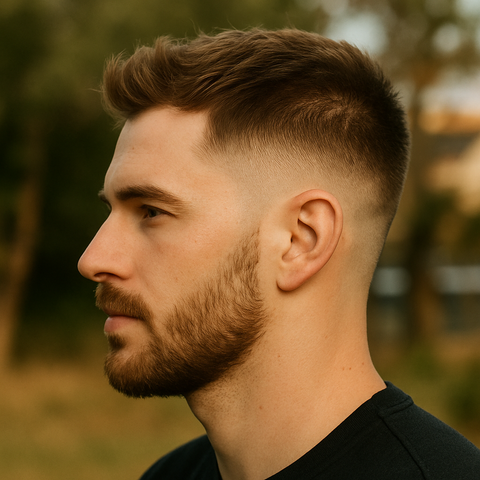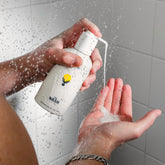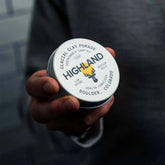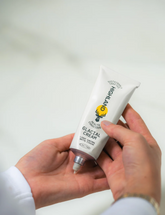
Low-Low Taper Fade: Why It’s So Popular and How to Keep Yours Fresh
Your fresh low low taper fade haircut shouldn't fade by day three.
Yet here you are, Wednesday morning, staring at a haircut that looked razor-sharp on Saturday.
The lines are blurring. The edges are fuzzy. And that clean, professional look? Already disappearing into your scalp.
You may think your fade shrank overnight. You’re not imagining things.
What Is a Low-Low Taper Fade?
A low-low taper fade is the subtlest fade you can get.
It’s part of the the popular low taper fade style, which is a great men's haircut for any occasion, and many hairt ypes.
It starts just above your ear — lower than a standard low fade — and gradually blends into your natural hairline with minimal contrast.
Low-low’ means exactly that — the fade sits ultra-low and subtle, blending softly instead of climbing high up the sides. (1)
Here's the technical breakdown:
Starting point: Hair begins to fade 0.5 to 1 inch above the ear.
Blend zone: Extremely tight, usually less than an inch of gradual transition.
Top length: Typically 1–3 inches, depending on your style.
Neckline: Clean and natural, following your hairline's shape.
The length on top stays longer for flexibility — think textured crops, curls, or slick-backs — all while keeping a crisp outline around the temples and neckline.
Quick context: In classic barber terms, a taper gradually reduces length above the ear and neckline without showing skin, while a fade blends right down to skin.
Your low-low sits between them — a taper-fade hybrid that keeps the polish but skips the flash.
How it differs from other fades:
Low fade: Starts 1–2 inches above the ear with more visible contrast.
Mid fade: Begins at temple level with dramatic blending.
High fade: Starts above the temples for maximum contrast.
Regular taper: Gradual length reduction without skin exposure.
The low-low taper fade is precision without flash. Clean without trying too hard. It’s a quiet flex — subtle, sharp, and always in control.
Who Does It Work Best For?
Short answer: Almost everyone. But let's get specific.
Straight Hair:
Perfect candidate. The subtle gradient shows beautifully without requiring heavy product. Your natural texture does the work.
👉 Just a touch of moisture, and you’re golden.
Wavy Hair
Even better. The low-low fade creates structure while your waves add movement up top. It's controlled chaos in the best way.
👉 That lived-in, effortless texture? This cut was made for it.
Curly Hair
This is where the cut shines. The tight blend at the bottom creates clean lines while your curls provide natural volume and texture above.
Use a blow-dryer with a diffuser if you want extra definition.
👉 Let your curls do their thing — the fade just frames it.
Thick Hair
The gradual taper removes bulk without creating harsh lines. You get shape without the helmet effect.
👉 No stiffness. No overstyling. Just flow.
Face Shapes That Win with specific low-low fades:
Oval: Universally flattering — the fade enhances your natural proportions.
Round: The subtle height on top creates length without extreme contrast.
Square: Softens angular features while maintaining masculine structure.
How to Ask Your Barber for the Right Cut
Here's where most guys mess up.
Walking in and saying, "Give me a low fade," will not get you this cut.
Neither will "taper fade" or "low taper."
You need to be specific.
Say this instead:
"I want a low-low taper fade. Start the fade just above my ear — really low — and keep the blend super tight and subtle.
No harsh lines, no disconnects.
Use a #1 guard at the base into a #2, scissor trim the top to around 2–3 inches, and keep the neckline natural."
Even better — bring some reference photos, which you can find further down in this article, or, in this one.
Show your barber multiple angles. One photo from the side isn't enough.
Show the back, the blend zone, and how it connects to the top.
Barbers aren’t mind readers — they’re artists.
Give them the full picture with specifics, and ask if they recommend a line-up or shape-up finish.
Critical Talking Points for Your Barber
What To Say: ✨
Specify "low-low" or "extra low" placement.
Ask for a "tight blend" or "subtle gradient".
Clarify your preferred top length.
Mention clearly if you want the neckline squared or natural.
What NOT to say: ⛔
"Just clean it up" (too vague).
"Make it short" (could mean anything).
"Like a military cut" (that’s a high fade).
Remember, your barber wants to nail this. Five minutes of clarity saves three weeks of regret.
Keeping Your Fade Looking Sharp Longer
Your fade starts dying the moment you leave the barbershop.
Oil production blurs the lines. Product buildup masks the blend.
Dead skin cells create fuzz where there should be clean edges.
But you can slow the decay. A few tweaks — and the Highland Way is all it takes.
The Clean Scalp Method:
| DAY | ACTION |
| Day 1–2 | Let your scalp breathe. No product, no washing. Your natural oils are actually protecting the cut. |
| Day 3–4 | Rinse with cool water only. Massage your scalp with your fingertips to prevent buildup without stripping oils. |
| Day 5–6 | Use a gentle, sulfate-free cleanser (like The Wash). Focus on your scalp, not your hair. The goal is balance, not squeaky-clean. |
| Day 7+ | Light styling product as needed. Our Clay Pomade is medium-hold and reworkable, plus it nourishes your hair and scalp. |
The Sharp Edge Secret:
Run a clean, soft towel along your hairline after every shower. This prevents water spots and product residue from blurring your edges.
Takes 5 seconds. Extends your fade by days. It’s the kind of tip your barber would give you off the record.
The Pillow Hack:
Switch to a silk or satin pillowcase. Both silk and satin help reduce friction, are smoother than cotton, and let your hair move more freely while you sleep.
Silk is the key player here - it’s proven that silk pillow cases keep your fade crisp and stop your hair from getting roughed up while you rest. (2)
Small switch. Big difference.
Mistakes That Kill Your Fade Fast
-
Overwashing with harsh shampoo:
Sulfates strip your scalp, triggering oil overproduction. That excess oil?
It's what makes your fade look greasy and undefined by day two. Follow our guide on shampoo alternatives.
-
Heavy pomades and waxes:
That "stronghold" pomade isn't holding your style — it's suffocating your scalp and creating buildup that blurs your fade lines.
-
Skipping the 2-week touch-up:
A low-low fade needs maintenance every 2–3 weeks. Wait longer, and you're not maintaining — you're starting over.
-
Hot water damage:
Scalding showers feel good but destroy your fade. Hot water swells hair cuticles and creates frizz right at your blend line.
-
Aggressive towel drying:
Rubbing your head with a towel doesn't dry your hair — it creates micro-abrasions that make your fade look fuzzy.
Pat. Don’t scrub. Your fade will thank you.
Visual Inspiration: The Low-Low in Action
Executive Low-Low

Textured Low-Low

Curly Low-Low

Classic Low-Low

Low Drop Fade

The Low Burst Fade

Bottom Line
The low-low taper fade isn't just another haircut trend. It's a philosophy.
Less flash, more finesse. Less maintenance, more longevity. Less product, more natural.
It’s balance — the kind that turns heads without trying.
Your fade deserves more than a weekend lifespan. With the right cut, the right products, and the right mindset, you can keep those lines clean for weeks, not days.
No harsh chemicals. No daily touch-ups. No fuss.
Just clean, confident, controlled style that works as hard as you do.
References:
1. 2. perplexity.ai/search/what-is-a-low-low-taper-fade-h-_OmJFtFwSuSELdCf7EyUug?0=d





